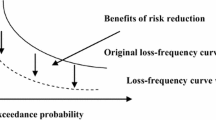Abstract
Many proponents of disaster mitigation claim that it offers potential benefits in terms of saved lives and property far exceeding its costs. To provide evidence for this, and to justify the use of public funds, agencies involved in mitigation can use benefit–cost analysis (BCA). Such analysis, if well done, offers a testable, defensible means of evaluating and comparing projects, helps decision-makers choose between mitigation projects, and provides a means to assess the way we spend public funds. In this critical overview of the more contentious issues and latest developments in BCA, I emphasize the pragmatic choices that one can make in accordance with good practice in project evaluation.
Similar content being viewed by others
References
Adler, M.D. and Posner, E.A.: 2001, Cost Benefit Analysis: Legal, Economic and Philosophical Perspectives, Chicago, University of Chicago Press.
Arrow, K., Solow, R., Leamer, P.R.E.E., Radner, R. and Schuman, H.: 1993, ‘Report of the NOAA panel on contingent valuation’, Federal Register 58, 4601–4614.
Arrow, K.J. and Lind, R.C.: 1970, ‘Risk and uncertainty’, reprinted in R. Layard and S. Glaister, Cost–Benefit Analysis, Cambridge, Cambridge University Press, 1994, pp. 160–178.
Bar-Yam, Y.: 2000, ‘Butterfly effect’, New England Complex Systems Institute, http://necsi.org/guide/concepts/butterflyeffect.html, accessed Feburary 18, 2003.
Boardman, A.E., Greenberg, D.H., Vining, A. R. and Weimer, D. L.: 2001, Cost–Benefit Analysis (2nd edn.), New Jersey, Prentice Hall.
Crone, A.J., Baum, R.L., Lidke, D.J., Sather, D.N.D., Bradley, L. and Tarr, A.C.: 2001, ‘Landslides induced by hurricane Mitch in El Salvador – An inventory and descriptions of selected features’, U.S. Geological Survey Open-File Report 01–0444.
Disaster Relief: 2000, website provided by American Red Cross, CNN Interactive and IBM, http://www.disasterrelief.org/, accessed January 28, 2003.
Federal Emergency Management Agency: March 1997, Report on Costs and Benefits of Natural Hazard Mitigation, Washington, DC.
Graham, D.A.: 1981, ‘Cost–benefit analysis under uncertainty’, Am. Econ. Rev. 71(4), 715–725.
Government Accounting Office: 1999, ‘Disaster assistance: Information on the cost effectiveness of hazard mitigation projects’, GAO/T-RCED-99-106.
Layard, R. and Walters, A.A.: 1994, ‘Income distribution’, reprinted in R. Layard and S. Glaister, Cost–Benefit Analysis, Cambridge, Cambridge University Press, pp. 179–198.
Mileti, D.S.: 1999, Disasters by Design, Washington, DC, Joseph Henry Press.
National Research Council: 1999, The Impacts of Natural Disasters, Committee on Assessing the Costs of Natural Disasters, Washington DC, National Academic Press.
Office of Management and Budget: 1994, ‘Guidelines and discount rates for benefit–cost analysis of federal programs’, circular no. A-94 (revised 2003).
Thompson, P. and Handmer, J.: 1996a, Economic Assessment of Disaster Mitigation: An Australian Guide, Middlesex, GB, Flood Hazard Research Center.
Thompson, P. and Handmer, J.: 1996b, ‘Economic assessment of disaster mitigation’, Center for Resource and Environmental Studies, ANU.
Roe, B., Boyle, K. and Teisl, M.: 1996, ‘Using conjoint analysis to derive estimates of compensating variation’, J. Environ. Econ. Manag. 31, 145–159.
Sen, A.K.: 1972, ‘Shadow prices and markets’, reprinted in R. Layard and S. Glaister, Cost–Benefit Analysis, Cambridge, Cambridge University Press, 1994, pp. 100–115.
Stevens, T.H., Belkner, R., Dennis, D, Kittredge, D. and Willis, C.: 2000, ‘Comparison of contingent valuation and conjoint analysis in ecosystem management’, Ecol. Econ. 32, 63–74.
Stiglitz, J.E.: 1994, ‘Discount rates: The rate of discount for benefit–cost analysis and the theory of the second best’, reprinted in R. Layard and S. Glaister, Cost–Benefit Analysis, Cambridge, Cambridge University Press, pp. 116–159.
Weitzman, M.L.: 2001, ‘Gamma discounting’, Am. Econ. Rev. 91(1), 260–271.
Zerbe, R.O. and Dively, D.D.: 1994, Benefit–Cost Analysis in Theory and Practice, New York, Harper Collins College Publishers.
Author information
Authors and Affiliations
Corresponding author
Rights and permissions
About this article
Cite this article
Ganderton, P.T. ‘Benefit–Cost Analysis’ Of Disaster Mitigation: Application As a Policy And Decision-Making Tool. Mitig Adapt Strat Glob Change 10, 445–465 (2005). https://doi.org/10.1007/s11027-005-0055-6
Received:
Accepted:
Issue Date:
DOI: https://doi.org/10.1007/s11027-005-0055-6




